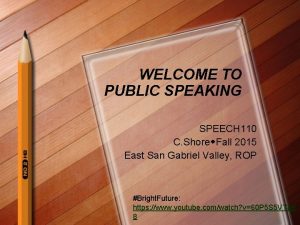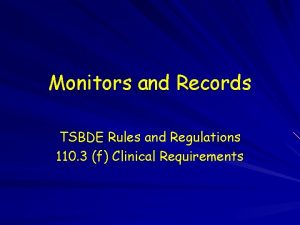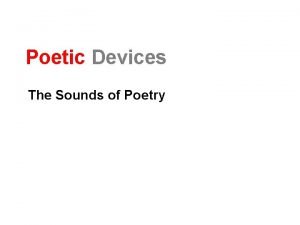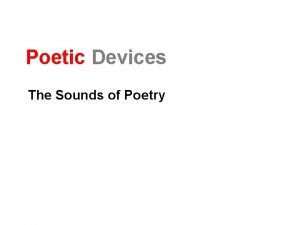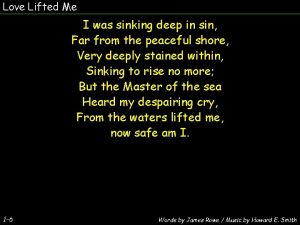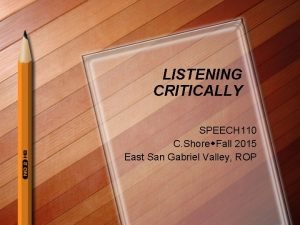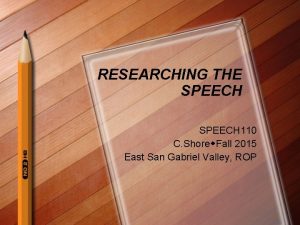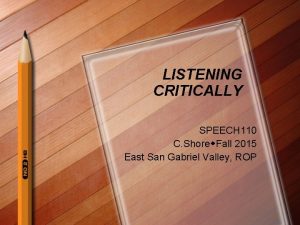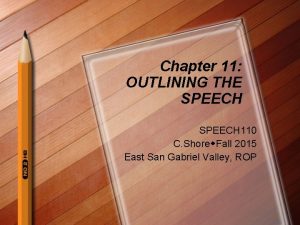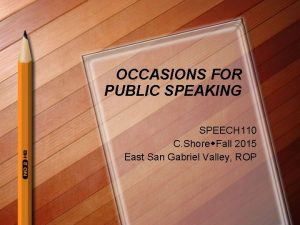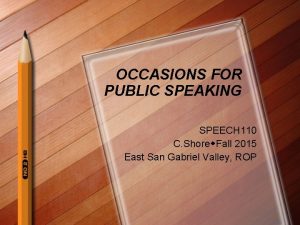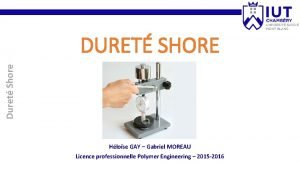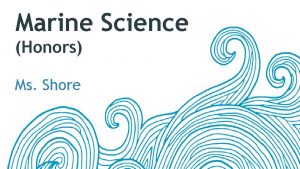Chapter 8 REASONING SPEECH 110 C Shore Fall


















- Slides: 18

Chapter 8 REASONING SPEECH 110 C. Shore Fall 2015 East San Gabriel Valley, ROP 1

Salvador Dali 2

Learning Objectives l l 8. 1: Explain the nature of rhetorical proof in public speaking and identify its three components. 8. 2: Define what a fallacy is and identify some general fallacies. 8. 3: Describe six basic patterns of reasoning and fallacies that correspond to particular patterns of reasoning. 8. 4: Explore how to avoid errors in reasoning. 3

Reasoning Overview l 2 types of statements – Objective l Quantitative l Mathematical – Subjective l Qualitative l Belief v. value l Judgment 4

8. 1: Proof, Support, and Reasoning l Components of Proof – Claims l What you want audience to accept – Supporting material l Evidence for claim – Reasoning (Inference) l Mental leap made to connect SM to C 5

The Toulmin Model l Claim – A statement that a speaker asks listeners to accept and that the speaker tries to prove. l Evidence – Grounds l l l Proof, research, data, etc. Where the warrant comes from Warrant – Answers the “why? ” question – Can be more than one – Because statement that comes from scholar telling you the claim is true 6

8. 1: Proof, Support, and Reasoning l Rhetorical Proof – proof establishing through intersection between the speaker and the listeners; provides support for a conclusion but not assurance that is true. l l Interplay between audience and speaker with supporting material Justifies claims, but not necessarily make it correct – Supporting materials function to support the claims/conclusions – Ask whether all statements marked by Roman numerals in outline, taken together, provide basis for inferring central claim 7

Types of Reasoning l l l Reasoning through Example Reasoning through Analogy Reasoning through Sign Reasoning through Cause Reasoning through Testimony Reasoning through Narrative 8

Proof and the audience l Audience as the overriding factor in supporting a claim and validity – (true: however audiences may be persuaded by outside noise) – the preemies’ don’t have to be true l l l all men are moral, Socrates is a man therefore Socrates is moral Audience diversity influences convincing force of the message, despite validity Reasonability: the ability of the audience to engage in the arguments that are presented; critically reflect. 9

8. 2: Fallacies l An inference that appears to be sound but on inspection contains a significant flaw. 1. 2. 3. 4. 5. 6. Fallacy of composition Fallacy of division Common cause Post hoc Red herring Ad hominem 10

8. 3: Example l l Specific instances to illustrate more general claims Types: – Individual vs. Aggregate (p 182) l Representatives vs. Group – Factual vs. Hypothetical (p 183) l Real vs. Make believe – Brief vs. Extended (p 183) l l Lists vs. Plotted/Lengthy Weaknesses – Fallacy of composition – What is true of the part is automatically true of the whole. – Fallacy of division – What is true of the whole, is true of the part. 11

8. 3: Analogy l l Analogy: comparison of people, places, things, events, or more abstract relationships/emotions. Types: – Literal – direct, like – Figurative – relationships, unlike 12

8. 3: Signs l l Sign: Something that stands for something else Types – Physical Observation l Regarding something that can be observed as a sign of something cannot – Statistical Index l A statistical measure that is taken as a sign of an abstraction – Institutional Regularity (norms & conventions) l A sign relationship that results from norm or social convention 13

8. 3: Cause l l Causal Inference: Influence of one thing on the other (Cause & Effect) Types – Prediction – Assignment of responsibility l Seeking out the cause – Explanation – Steps to a goal l Fallacies – Common Cause: Assuming that one thing causes another when in fact a third factor really is the cause of both – Post hoc: Assuming that because one event occurred before another, the first is necessarily the cause of the second 14

8. 3: Testimony l l Relies on other people for supporting materials Types – Fact vs. Opinion – Expert vs. Lay Testimony l Testimony from a person who is generally recognized as an authority on a particular subject vs. testimony from a person who is not an expert – Quoted vs. Paraphrased l Pontificating – Offering judgments without providing any basis for them (not giving a reason) 15

8. 3: Narrative l l Broad or abstract ideas made personal and particularized Types – Sequence of episodes (plots) – Resolution of conflict l l l Limited identification; only certain people will understand. No visible climax or story line from A->B Resonance: the quality if striking a response chord with listeners, causing them to identify with what one is saying Fallacy – Red Herring: straying from the original claim; distracted from the intended focus/argument – Ad hominem: personal attacks 16

8. 4: Avoiding Errors in Reasoning l 1. 2. 3. Six General Tests of Inference Does the claim follow the support? Does the claim promote knowledge? Is the claim relevant? 4. 5. 6. Is the language clear? Are probability and certainty distinguished? Are speaker’s emotions appropriate? 17

Take Away l 8. 1: Explain the nature of rhetorical proof in public speaking and identify its three components. – Provides sound arguments for thesis – Claim, Supporting material, reasoning (Toulmin model) l 8. 2: Define what a fallacy is and identify some general fallacies. – Illogical lines of reason l 8. 3: Describe six basic patterns of reasoning and fallacies that correspond to particular patterns of reasoning. – Example, Analogy, sign, cause, testimony, narrative l 8. 4: Explore how to avoid errors in reasoning. – Ask 6 specific questions for each inference to determine 18 whether the reasoning seems sound
 Numero niss
Numero niss 110-000-110 & 111-000-111
110-000-110 & 111-000-111 Deductive reasoning
Deductive reasoning Deductive reasonign
Deductive reasonign Deductive argument examples
Deductive argument examples Deductive learning vs inductive learning
Deductive learning vs inductive learning Every quiz has been easy. therefore, the quiz will be easy
Every quiz has been easy. therefore, the quiz will be easy Inductive reasoning is reasoning based on patterns
Inductive reasoning is reasoning based on patterns Concept of logical reasoning
Concept of logical reasoning Speech 110
Speech 110 Tsbde rules and regulations
Tsbde rules and regulations Drip-hiss-drip-hiss fall the raindrops figure of speech
Drip-hiss-drip-hiss fall the raindrops figure of speech Poetic devices sound
Poetic devices sound 2 post vertical shore
2 post vertical shore Shore reception facilities
Shore reception facilities Upper shore
Upper shore Muddy shore redox potential
Muddy shore redox potential When nothing else could help
When nothing else could help Rocky shore adaptations
Rocky shore adaptations









